- B-Stock Polish Pottery – Sorted & Unique
- Bowls
- Butter Dishes
- Mugs
- Plates
- More
- Jars
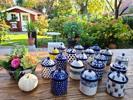
- Outlet
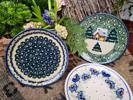
- Baking Dishes made of Boleslawiec Pottery
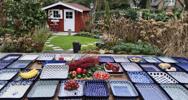
- Polish Pottery Platters – Wide Selection of Shapes & Sizes
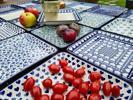
- Jugs & Pitchers – Wine, Water, Juice, Milk – Polish Pottery

- Wintry

- Decoration
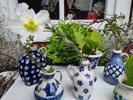
- Teapots & Coffee Pots in Bolesławiec Polish Pottery

- Artists
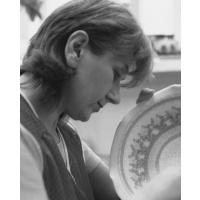
- Faith – Christianity – Polish Pottery

- 1000 and a cup
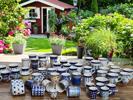
- Custom made

- Exclusive Polish Pottery

- Gift Voucher for Polish Pottery – Give Handcrafted Quality

- Over 4600 Polish Pottery Patterns

- Unique pieces Polish pottery
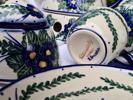
- Polish Pottery Sets & Second Choice – Beauty at a Great Price

- Saucier – Cooking with Polish Stoneware

- Soup Kitchen – Polish Pottery

- Complete service
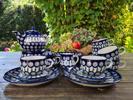
- Exhibition Room
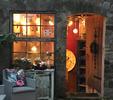
- Bathroom & WC – Polish Pottery by Ceramika Artystyczna

- Pizza Baking – Polish Pottery

- Vases in Polish Pottery – Ceramika Artystyczna
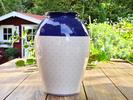
- Chef Pâtissier – Sweet and Savoury – in, on and with Polish Pottery

- Garde-Manger – Cooking with Polish Pottery Tableware

- Plongeur – Cleaning Polish Pottery Tableware

- Rôtisseur – Cooking with Polish Pottery

- Polish Pottery Sets at Discount Prices

- For the Danish Kitchen – Ceramic Tableware

- Grillardin – Grilling, Smoking & Barbecue with Polish Pottery

- Bulk Discount – Save on Polish Pottery
- Customer Service & FAQs – Polish Pottery
- Sweet Dreams

- For the German Kitchen – Polish Pottery Tableware

- The History of Polish Pottery
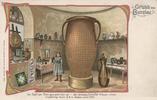
- For the Polish Kitchen – Polish Pottery

- For the Spanish Kitchen – Polish Pottery

- Ceramika Artystyczna - The Queen of Polish Pottery Ceramics

- Dishes for lovers
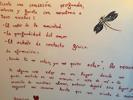
- Polish pottery gallery

- Sustainability

- Polish Ceramics from Ceramika Manufaktura

- Breakage-Free Guarantee – Safe Delivery of Your Polish Pottery
- Polish Pottery – Safe, Food-Safe & Everyday-Ready
- Reorder Guarantee – Your design available for many years
- Cookbook – Recipes and Cooking with Polish Pottery by Gourmet Chef Christian Kindervater

- Special Shipping Requests

- Gift Wrapping – Polish Pottery
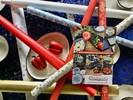
- Trusted Shops Buyer Protection – Excellent Shop – Certified for 17 years (since 15/05/2008) – Bunzlauergrosshandel.de

- Jars
Welcome to the world of rectangular polish pottery bowls from Ceramika Artystyczna, the most renowned workshop for Polish stoneware. Each piece is formed in Bolesławiec (Poland) from lead‑free stoneware clay, decorated by hand with sponge and brush techniques, and fired at around 1,250 °C. This creates bowls that
withstand oven, microwave and freezer use (up to approx. 250 °C)
are dishwasher‑safe as well as scratch‑ and cut‑resistant
retain heat – or cold – for a long time
enchant every table with cobalt‑blue, green or red folk patterns
Typical Sizes & Uses
XXS (7–10 cm): mini dish for keys, jewellery, salt, mise‑en‑place spices
XS–S (12–18 cm): herb seed starter tray, tapas or snack bowl
M (20–26 cm): bread or fruit bowl, side‑dish gratin
L (28–32 cm): family‑size lasagne or roasting dish
XL (34 cm and larger): party casseroles, tiramisù for a crowd, chocolate mousse
The rectangular shape makes full use of oven space and stacks neatly in the cupboard – practical and space‑saving.
Recipe 1: Portuguese Vegetable Bake “Legumes ao Forno”
Serves: 4 Prep: approx. 20 min Bake: approx. 40 min
Ingredients
400 g small potatoes, pre‑boiled and halved
2 carrots, sliced
1 red bell pepper, diced
1 courgette, half‑moons
2 ripe tomatoes, diced
1 × 400 g tin chickpeas, rinsed
1 onion, chopped
2 garlic cloves, finely chopped
150 ml passata
150 ml vegetable stock
2 tbsp olive oil
1 tsp smoked paprika
Dried oregano, salt, pepper to taste
Handful fresh parsley, roughly chopped
Method
Pre‑heat oven to 190 °C top/bottom heat.
Sauté onion and garlic in olive oil until translucent.
Add carrots, bell pepper and courgette; fry for 5 minutes.
Stir in potatoes, tomatoes and chickpeas. Season with paprika, oregano, salt and pepper. Pour in passata and stock; bring briefly to a boil.
Transfer everything to a medium rectangular polish pottery bowl, cover with lid or foil and bake 30 minutes.
Remove cover, bake 10 minutes more until lightly browned. Sprinkle with parsley and serve straight from the ceramic dish.
Recipe 2: Classic Tiramisù with Homemade Ladyfingers
A) Ladyfingers (makes about 40)
Ingredients
4 eggs (size M), separated
100 g caster sugar
1 tsp vanilla sugar
90 g plain flour
30 g cornflour
¼ tsp baking powder
Icing sugar for dusting
Method
Heat oven to 190 °C fan. Line a tray with baking paper.
Beat egg yolks, 60 g sugar and vanilla sugar until pale and thick.
Whisk egg whites to stiff peaks, adding remaining 40 g sugar gradually.
Fold meringue gently into yolk mixture.
Sift flour, cornflour and baking powder over and fold in carefully.
Pipe 8 cm strips (12 mm round tip) onto tray, dust generously with icing sugar and bake 10–12 minutes until golden. Leave to cool.
B) Tiramisù (fits a 30 × 20 cm bowl)
Ingredients
4 very fresh eggs
120 g sugar
500 g mascarpone
250 ml strong espresso, cooled
3 tbsp Marsala or Amaretto
Unsweetened cocoa powder for dusting
Method
Whisk egg yolks with 80 g sugar until thick and creamy. Beat in mascarpone a spoonful at a time.
Whisk egg whites with remaining 40 g sugar to stiff peaks and fold into the cream.
Combine espresso and Marsala. Dip each ladyfinger briefly (do not soak) and line the base of the rectangular polish pottery bowl tightly.
Spread half the mascarpone cream on top. Add a second layer of dipped biscuits and finish with the remaining cream.
Chill at least 4 hours – preferably overnight. Dust generously with cocoa before serving and present the dish directly in its ceramic showpiece.
Tip: Thanks to the excellent thermal retention of polish pottery, the vegetable bake stays hot and the tiramisù stays cool for longer – no need to transfer to another vessel. Beauty and function meet effortlessly in your kitchen.









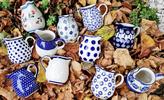
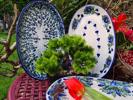





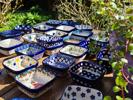
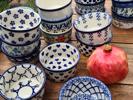
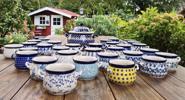
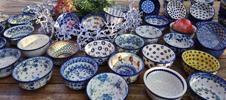
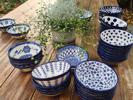
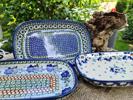
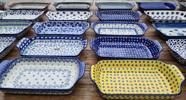
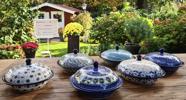

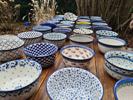
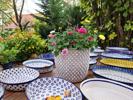
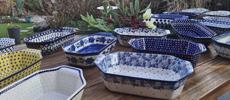
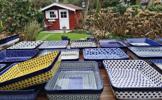
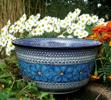
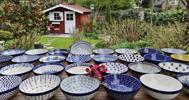
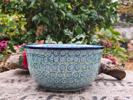
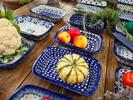
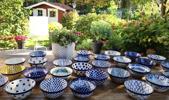
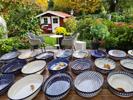

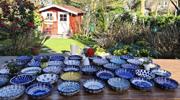
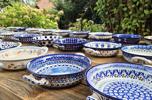

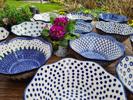
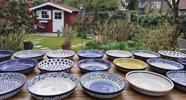
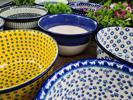
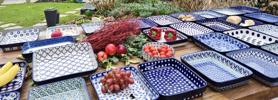
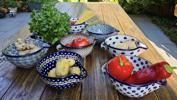
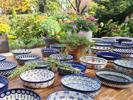
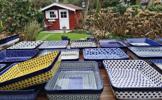


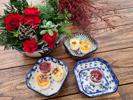





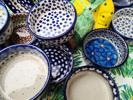

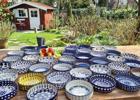
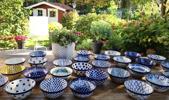

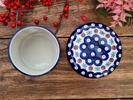
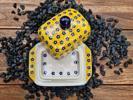
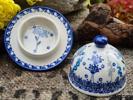


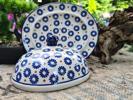




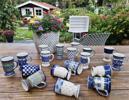












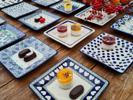
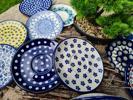

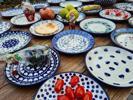
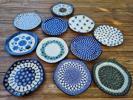
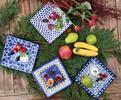
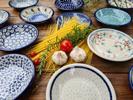
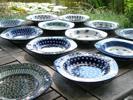
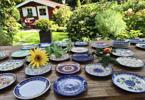

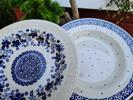
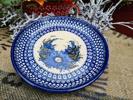

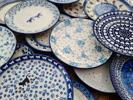
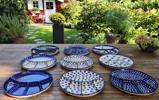

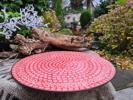
 Plenty Lions
Plenty Lions